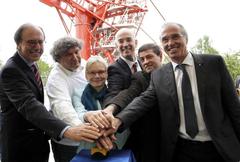URL: https://www.desy.de/news/news_search/index_eng.html
Breadcrumb Navigation
DESY News: Inauguration of CTA gamma telescope prototype
News
News from the DESY research centre
Inauguration of CTA gamma telescope prototype
Today, at the Berlin Science Park Adlershof, DESY commissioned the first telescope prototype of the Cherenkov Telescope Array CTA. In an inauguration ceremony, Professor Sabine Kunst, science minister of the German federal state of Brandenburg, Dr. Karl Eugen Huthmacher, head of department at the German Federal Ministry of Education and Research BMBF, Professor Helmut Dosch, chair of the DESY board of directors, and Professor Christian Stegmann, head of the DESY institute in Zeuthen, jointly commissioned the prototype. In the coming months, the fully functional full-scale model of the medium-sized of the planned three CTA telescope types will be used to test all functions for future operation at the CTA facility.

The CTA, developed in an international cooperation, is a planned ensemble of different-sized telescope types which will measure high-energy cosmic gamma rays. Scientists will use it to explore the universe for cosmic particle accelerators, e.g. supernova explosions, binary star systems or active galactic nuclei. “The Cherenkov Telescope Array will observe thousands of these objects with unprecedented sensitivity and substantially enhance our understanding of the universe,” said Professor Christian Stegmann. “It will be the gamma astronomy observatory of the future.” DESY is the largest group within the international project and is responsible for design and construction of the medium-sized telescope with a mirror diameter of about 12 metres. “With our comprehensive participation in CTA, we continue to extend the central role of DESY in Zeuthen in astroparticle physics in Germany and worldwide,” said Professor Helmut Dosch.
“Over 1000 scientists and engineers from over 25 countries from all around the globe are working since 2006 towards CTA. The DESY team lead by Stefan Schlenstedt has made an outstanding work in preparing this prototype and getting it operational,” underlined Professor Manel Martinez (IFAE Barcelona), spokesperson of CTA.
Brandenburg’s science minister Professor Sabine Kunst emphasised the impact for the region: “DESY in Zeuthen substantially contributed to the development and installation of this prototype and it will also participate in the operation of the Cherenkov Telescope Array. Congratulations to all DESY staff for their good work which is also beneficial for the region. There are jobs for 200 people; many students of the Wildau University of Applied Sciences, the Brandenburg University of Technology Cottbus and the University of Potsdam work here for their bachelor and master theses, and PhD students from Berlin and Brandenburg are here to do research.”
CTA, which was recently included as one of three excellent large-scale projects into the BMBF roadmap for large-scale research infrastructures, is expected to start construction in 2015 at two sites, one in the northern and one in the southern hemisphere. The smaller area in the northern hemisphere will have 20 to 30 telescopes distributed over a square kilometre; the larger, southern area will include 70 to 100 telescopes extended over ten square kilometres. Dr. Karl Eugen Huthmacher from the BMBF pointed out: “Basic research is an essential foundation for prosperity in our knowledge-based society and it sets course for tomorrow. In the field of astroparticle physics, CTA will make a major contribution to strengthen our research landscape.”
The German contribution to the construction costs amounts to about 50 million euros. By including the project into the roadmap, the BMBF declared their readiness to in principle provide funds for the construction of CTA. Apart from DESY, the German contribution is financed by the Max Planck Society and particularly by the BMBF which also supports German universities in the project.
The prototype in Berlin-Adlershof was designed and built by DESY. It will be used to test and optimise the drive and safety systems of the telescope in motion. Simultaneously, it includes the measuring of the mechanical properties of the telescope, e.g. vibrations and deformations, the star light focussing of the camera during mirror adjustment and accurate telescope alignment to a celestial object.
More information on CTA: www.desy.de/cta




